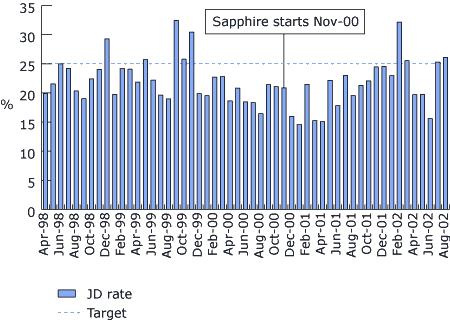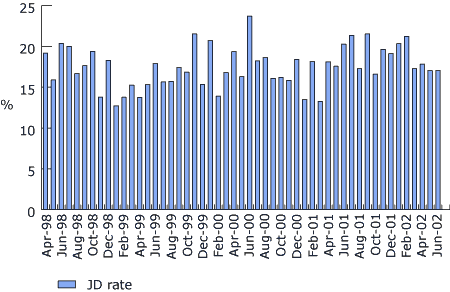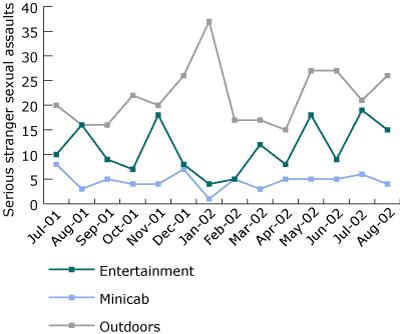Contents
Report 8 of the 11 Nov 02 meeting of the Planning, Performance & Review Committee and examines the factors that impact on the judicial disposal performance rate for rape and also explores wider issues relating to allegations of rape reported to police in London.
Warning: This is archived material and may be out of date. The Metropolitan Police Authority has been replaced by the Mayor's Office for Policing and Crime (MOPC).
See the MOPC website for further information.
Rape judicial disposal performance
Report: 08
Date: 11 November 2002
By: Commissioner
Summary
The judicial disposal (JD) rate for rape in the first quarter of 2002 dropped to 18.3%, 6.7% below the target of 25% in the annual Policing Plan. The rate for the second quarter of 2002, however, has increased to 26.3%. The half-year rate is now 22.4% compared with 19.85% last year, an increase of 2.55%. This report examines the factors that impact on the JD rate for rape and also explores wider issues relating to allegations of rape reported to police in London.
A. Recommendation
Members are asked to support the steps being taken by Project Sapphire to improve victim care for rape victims and the investigation of rape.
B. Supporting information
1. In September the MPS Performance Review Committee (PRC) requested a report on rape that addressed the following issues:
- Offenders (stranger/known)
- Victims (male/female)
- Domestic/non –domestic
- Drug related offences
The PRC also requested that the report examine the impact of the rape profile on:
- the judicial disposal rate; and
- attrition in the criminal justice system
The PRC also requested an update on the work that the MPS is doing around the investigation of drug-related offences.
2. The MPA Planning, Performance and Review Committee has also asked for:
- analysis of the fall in the judicial disposal rate (April to June);
- action being taken by the MPS to address the recent fall,
- an overview of performance levels in reporting rape by different racial and ethnic groups and the extent to which processes are in place to address such differences; and
- details of progress against the key recommendations arising from reports by HMIC, Home Office and MPA highlighting key actions and resource issues that need to be brought to the attention of the MPA.
3. This report attempts to provide the PRC and the MPA with an analysis that satisfies the questions posed above.
Underlying judicial disposal rate for rape
4. Taking account of the monthly judicial disposal rate over the past four years, it can be seen at Graph 1 that the underlying trend continues to increase and has done so since November 2000 when Project Sapphire was started. The JD rate for rape for September increased to 27.6%.
Graph 1 showing the MPS judicial disposal rate for rape

5. It is of concern that the judicial disposal rate for rape was low in the months of April, May and June of this year. However, this must be seen in the context of the rate for the second quarter (July - September) which averaged 26.3%, 1.3% above the MPS target. It is also positive that the MPS has reached the 25% target in five out of the last eight months. Furthermore, the half yearly JD rate for rape (April - Sept) is 22.4% compared with 19.85% for the same period last year, an increase of 2.55%.
6. The reductions in judicial disposal rate at the boroughs of Islington and Camden are noteworthy as these boroughs account for a large proportion of the allegations of rape in the MPS. Islington is currently one of only two boroughs in the MPS with no dedicated Sapphire unit although the launch of a new Sapphire team is imminent (4 November 2002). The reason for the drop in rate at Camden is currently being looked into but it is suggested that an absence of a Haven in north London is having a detrimental impact on victim care and performance. It is interesting to note that the JD rate for south-east London (serviced by the Haven) is double that of north-east London where there is no such facility. Project Sapphire is convinced that the JD target is achievable providing boroughs comply with the minimum standards outlined in the recently published policy (Special Notice 11-02, available on request) and providing that two more Havens can be established in north London.
7. The final borough to have a Sapphire team is Sutton. However, Sutton is to brigade with Croydon Borough, which will involve the transfer of one SOIT officer and one detective to the Croydon Sapphire team, which will take place in November.
Detailed analysis of reported rape (April - June 2002)
8. Of the total number of sexual offences recorded by the MPS during April-June 2002, 25.2% (701 offences specifically) were classified as rape and of these 94.9% (665 offences) the rape of a female. When breaking this information down further, it is evident that the number of rapes recorded has continually increased since 1998/99 when 468 were committed between April - June. Specifically, Newham recorded the largest number of rapes during April - June 2002 with 46, whilst Lambeth recorded the second largest number with 38. However, major differences existed between the boroughs with Richmond (5) and Kensington and Chelsea (6) each recording the lowest totals.
Persons accused of rape (April - June 2002)
9. Whilst 135 persons were accused of rape during April - June, those accused of rape were predominantly of an African-Caribbean (59 persons) or White-European ethnic appearance (54 persons). The 24 - 29 age group contained the largest number of persons accused with 33 persons, while 31 persons aged 30 - 39 were accused.
Victims of rape by age (April - June 2002)
10. 30% of victims of rape were under 18 years of age i.e. juveniles, 39% were aged 18-29 years and 12% were over 40 years of age.
Victims of rape by ethnic appearance (April - June 2002)
11. Examining the characteristics of victims of rape indicates that of the total 694, 58.6% (407 victims) were recorded as White-European ethnic appearance. Graph 3 shows the breakdown of ethnic group for victims of sexual offences over the three-month period. More detailed analysis is needed before conclusions can be drawn as to whether any particular group is disproportionately represented. However, a variety of anecdotal external sources have indicated that certain minority communities are significantly under represented in the statistics. The reasons for this are largely cultural and religious but also may be due to lack of confidence in the police.
Graph 3: Breakdown of victims by ethnic appearance (Apr-Jun 2002)
This graph is available from the MPA.
12. Project Sapphire is planning to undertake a seminar for stakeholders from hard to reach groups such as the Somali and Asian communities. The project has identified Sexual Offence Trained Officers (SOIT) with these ethnic backgrounds and intends running a campaign to encourage reporting in the future. The Haven has demonstrated that a service of anonymous self-reporting encourages victims from hard to reach groups to report rape. The further roll out across London of Haven centres will, therefore, increase reporting from these hard to reach groups.
Victim/suspect relationship for rape (April - June '02)
13. Nearly two thirds (68%) of the total rape victims (470 victims specifically) recorded having some kind of relationship with the suspect(s), the remainder (32%) were 'stranger' attacks. Excluding the ‘other relationship’ category, the most common relationships stated were that of ‘partner’ which included 22% of all relationships stated (105 victims specifically), and ‘ex-partner’ that included 14% (64 victims) during April-June 2002. Of the other categories mentioned only the ‘social’ victim-suspect relationship recorded any significantly large numbers, with 13% (59 victims) listing such a relationship.
Victim/suspect relationship for rape (July 01 - July 02)
14. Graph 2 below shows the level of intimate, acquaintance and stranger offences between July 2001 and July 2002. All fluctuations in the data are random and no trend is evident.
Graph 2: Rape and indecent assault per month – victim/suspect relationship (n=6969)
This graph is available from the MPA.
Allegations classified 'no-crime'
15. During April - June 2002, 17% of all allegations of rape made throughout the MPS were subsequently ‘no crimed’ with variation evident between boroughs. For example, within Kensington and Chelsea 65% of the 20 allegations of rape were ‘no-crimed’, whilst just 3% of 36 allegations ‘no-crimed’ within Greenwich.
16. The variation in no-crime rates across the MPS has been addressed by the issuing of Special Notice 11-02, which lays down explicit guidelines on when offences can be categorised as 'no-crime'. Further, Project Sapphire is engaged in a series of presentations to Senior Management Teams across the service where this subject is explained.
17. Graph 3 below shows that the underlying MPS 'no-crime' rate for rape since 1998. It can be seen that the rate averages out at 17% but is now falling (probably as a result of increased awareness of the new MPS policy).
Graph 3: showing MPS no-crime rate for rape April 1998-June 2002

Specific categories of rape examined
18. Graph 4 below shows a comparison between three different specific categories of approach type: minicabs (illegal or otherwise), outdoors and entertainment venues. Although the data appears to fluctuate to a certain extent, there are only two increases that are statistically significant: July 2001 – Minicab (8 offences); January 2002 – Outdoors (37 offences).
Graph 4: Categories of approach type per month – female victims (July 02 - August 02) (n=991)

19. Project Sapphire has recently launched a campaign with the Mayor of London to raise awareness of the connection between illegal minicabs and sexual assault/rape. The campaign entitled 'Know what you are getting into?' has been rolled out across the capital in the form of posters and media bulletins.
Drug rape and group/gang rape
20. Graph 5 below details the levels of drug and group rape between July 01 and August 02. Increases that are statistically significant are June 2002-Group rape (27 offences); July 2002-Drug rape (14 offences).
Graph 5: Drug rape and group rape per month – female victims (n=226)
This graph is available from the MPA.
Drug assisted rape
21. There are growing concerns about drug-assisted rape, although there is currently no detailed analysis of the size and nature of this crime problem. Academic research is suggesting that most instances of this type of rape are not reported to police. Further, when victims are coming forward, forensic evidence is not being secured early enough to prove that a drug has been administered.
22. In order to address this issue, Project Sapphire has launched a crime prevention awareness campaign across London warning of the dangers of leaving drinks unattended. In addition, a new Early Evidence Kit has been designed, piloted and now distributed across London in an attempt to capture evidence (e.g. urine samples) more quickly. A training programme for all front line officers is also being rolled out.
23. Strategic analysis of the extent and nature of reported drug rapes has been commissioned.
Group/gang rape
24. Group rape is defined as any offence committed against a victim by two or more perpetrators. Similarly, it is possible to identify indecent assaults where more than one perpetrator has participated.
25. Strategic analysis of group rape is currently being undertaken by SO11. Early findings indicate that most victims are juveniles and most perpetrators under twenty-five years of age. There are also strong links evident between group rape and street criminality.
Impact of rape profile on judicial disposal rate and attrition
26. It is not possible to determine the connection between rape profile and attrition without employing case trackers owing to the limitations of MPS information systems. Two case trackers have been selected for Project Sapphire to undertake this work but a current prohibition on further transfers into territorial policing head quarters is delaying the start of this work.
27. In order to address the deficiency in information systems Project Sapphire has been in detailed negotiations with the Crime Recording and Incident System (CRIS) refresh project who are currently designing new pages relating to sexual offences for the 10.1 version due early next year. This will enable analysis to be carried out on different categories of rape, the monitoring of attrition and a host of other benefits.
Progress against key recommendations from HMIC, home office, and MPA
28. Project Sapphire has achieved the following significant successes over the past six months in relation to key recommendations emanating from the above reports:
- Agreement reached with the Department of Health for the shared funding of three Sexual Assault Referral Centres (SARCs) to provide victims with pan London service. Implementation of two new Havens can be commenced fully as soon as a commitment has been secured from the MPA for on-going funding.
- Thirty out of thirty-two boroughs have dedicated Sapphire teams of officers trained to deal with rape and sexual assault. Eight boroughs in the MPS now have dedicated detectives investigating rape alongside SOIT officers. At its meeting on 14 October 2002, the Finance Committee agreed to the inclusion of the rape havens in the budget submission. A further report to the Finance Committee on 24 October 2002 sought approval for committing expenditure in the current financial year.
- Minimum standards have been written and a new policy for the investigation of rape and serious sexual assault published (see special notice 11-02).
- Seminars have been held with station reception officers to inform them how to deal with a victim of rape reporting to a police station. A seminar was also held with borough trainers in order for them to deliver training to front line officers. This training includes awareness of drug-assisted rape and the new early evidence kits. The current SOIT officer course is under review and a new updated course will start in the New Year.
- Preventative campaigns for drug rape and mini-cab rape have been delivered across the capital.
- A review of forensic submissions for the investigation of rape has been completed.
- Cold case review of unsolved stranger rapes has been started.
29. Project Sapphire is now assisting A/AC Godwin (ACPO lead for adult sexual offences) with implementation of the national Home Office action plan and is engaged with politicians and the Home Office in the shaping of a new White Paper for changing primary legislation for rape and sexual assault.
C. Equality and diversity implications
The equality and diversity implications that relate to this issue are outlined in the body of the report, particularly paragraphs 9 to 11.
D. Financial implications
1. On 4 October 2002 the MPA’s Co-ordination and Policing Committee meeting provisionally resolved to make the expansion of the Havens one of three new initiative priorities. The creation of two further Havens is critical to improving victim care to victims of rape, reducing attrition and to achieving convictions. The cost to the MPA of a pan London Haven coverage is estimated to be £1.5m yearly revenue costs with £0.5m capital/start-up costs. The Finance Committee held on 14 October 2002 reached an agreement to include rape havens in the budget submission.
2. The minicab public awareness advertising campaign has cost £50,000, with the MPS contributing £15,000 towards this, which has been taken from the Directorate of Public Affairs budget for crime priorities. The Mayor, Transport for London and the City of London Police have paid for the remaining £35,000. It is not possible at this stage to give reliable predictions as to the success, however a review of the number of the allegations will be made in six months time with regular reviews made following that. The campaign is due to run indefinitely.
3. The cost of the drug rape awareness campaign is £3,000, a poster campaign that will be distributed around the MPS to licencees by the MPS’ licencing officers and Operation Sapphire teams. This is also an ongoing campaign and will be reviewed every six months.
E. Background papers
- The quarterly statistical package on Rape / Sexual Offences produced by PRS7 (3)
- A summary of the Rape / Sexual Offences Statistical package (April to June and July to September, produced by PRS7(2)
- SO11 strategic analysis produced by the Sexual Offences Unit within the Service Intelligence Unit (SIU).
F. Contact details
Report author: Richard Walton, MPS.
For more information contact:
MPA general: 020 7202 0202
Media enquiries: 020 7202 0217/18
Supporting material
The following is also available as a PDF document:
- Appendix 1 [PDF] MPS Performance Report – September 2002
Send an e-mail linking to this page
Feedback